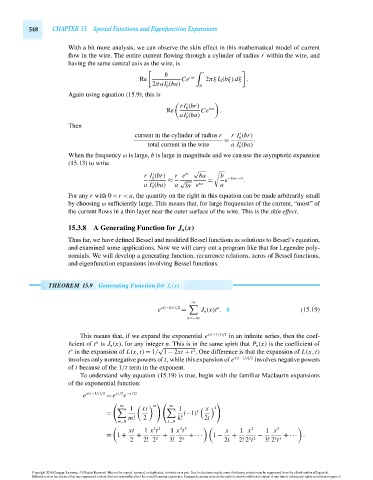Page 568 - Advanced_Engineering_Mathematics o'neil
P. 568
548 CHAPTER 15 Special Functions and Eigenfunction Expansions
With a bit more analysis, we can observe the skin effect in this mathematical model of current
flow in the wire. The entire current flowing through a cylinder of radius r within the wire, and
having the same central axis as the wire, is
r
b
Re Ce iωt 2πξ I 0 (bξ)dξ .
2πaI (ba) 0
0
Again using equation (15.9), this is
rI (br) iωt
0
Re Ce .
aI (ba)
0
Then
current in the cylinder of radius r r I (br)
0
= .
total current in the wire a I (ba)
0
When the frequency ω is large, b is large in magnitude and we can use the asymptotic expansion
(15.13) to write
√
r I (br) r e br ba b −b(a−r)
0
≈ √ = e .
a I (ba) a br e ba a
0
For any r with 0 < r < a, the quantity on the right in this equation can be made arbitrarily small
by choosing ω sufficiently large. This means that, for large frequencies of the current, “most” of
the current flows in a thin layer near the outer surface of the wire. This is the skin effect.
15.3.8 A Generating Function for J n (x)
Thus far, we have defined Bessel and modified Bessel functions as solutions to Bessel’s equation,
and examined some applications. Now we will carry out a program like that for Legendre poly-
nomials. We will develop a generating function, recurrence relations, zeros of Bessel functions,
and eigenfunction expansions involving Bessel functions.
THEOREM 15.9 Generating Function for J n (x)
∞
n
e x(t−1/t)/2 = J n (x)t . (15.19)
n=−∞
This means that, if we expand the exponential e x(t−1/t)/2 in an infinite series, then the coef-
ficient of t is J n (x), for any integer n. This is in the same spirit that P n (x) is the coefficient of
n
√
n
t in the expansion of L(x,t) = 1/ 1 − 2xt + t . One difference is that the expansion of L(x,t)
2
involves only nonnegative powers of t, while this expansion of e x(t−1/t)/2 involves negative powers
of t because of the 1/t term in the exponent.
To understand why equation (15.19) is true, begin with the familiar Maclaurin expansions
of the exponential function:
e
e x(t−1/t)/2 = e xt/2 −x/2t
m
∞
∞ k
1 xt 1 x
k
= (−1)
m! 2 k! 2t
m=0 k=0
2 2 3 3
2 3
xt 1 x t 1 x t x 1 x 1 x
= 1 + + + + ··· 1 − + − + ··· .
2 2
3 3
2 2! 2 2 3! 2 3 2t 2! 2 t 3! 2 t
Copyright 2010 Cengage Learning. All Rights Reserved. May not be copied, scanned, or duplicated, in whole or in part. Due to electronic rights, some third party content may be suppressed from the eBook and/or eChapter(s).
Editorial review has deemed that any suppressed content does not materially affect the overall learning experience. Cengage Learning reserves the right to remove additional content at any time if subsequent rights restrictions require it.
October 14, 2010 15:20 THM/NEIL Page-548 27410_15_ch15_p505-562

